Observation and Analysis in Early Childhood Development ECE 114
VerifiedAdded on 2022/09/07
|24
|6552
|22
Homework Assignment
AI Summary
This assignment focuses on the observation and analysis of child development in early childhood settings. The student analyzes three video clips, two featuring infants and one featuring a toddler, documenting their actions, behaviors, and the responses of adults. The assignment uses observational tools to identify developmental areas and specific skills, following the guidelines of ECE 114 Child Development course. The analysis is structured using charts to detail various developmental areas like physical, communication/language, cognitive, emotional, and social domains. The student provides evidence from the observed behaviors, highlighting skills such as gross and fine motor skills, non-verbal communication, attention regulation, cause-and-effect exploration, and social interest. The student then uses these observations to reflect on transformative practices in early childhood education.

Running Head: SOCIOLOGY 1
Early Childhood Education and Care
Name of University
Early Childhood Education and Care
Name of University
Paraphrase This Document
Need a fresh take? Get an instant paraphrase of this document with our AI Paraphraser
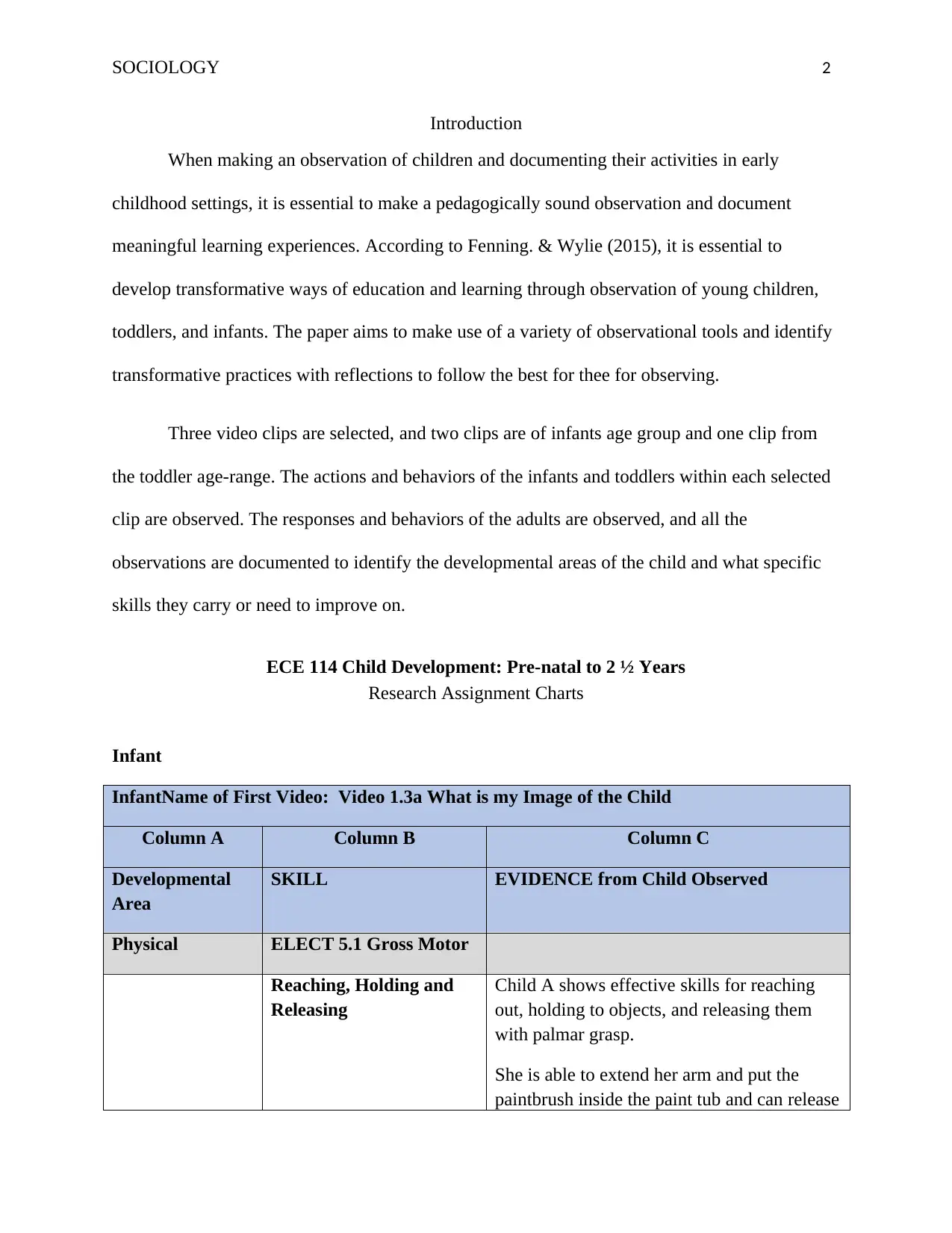
SOCIOLOGY 2
Introduction
When making an observation of children and documenting their activities in early
childhood settings, it is essential to make a pedagogically sound observation and document
meaningful learning experiences. According to Fenning. & Wylie (2015), it is essential to
develop transformative ways of education and learning through observation of young children,
toddlers, and infants. The paper aims to make use of a variety of observational tools and identify
transformative practices with reflections to follow the best for thee for observing.
Three video clips are selected, and two clips are of infants age group and one clip from
the toddler age-range. The actions and behaviors of the infants and toddlers within each selected
clip are observed. The responses and behaviors of the adults are observed, and all the
observations are documented to identify the developmental areas of the child and what specific
skills they carry or need to improve on.
ECE 114 Child Development: Pre-natal to 2 ½ Years
Research Assignment Charts
Infant
InfantName of First Video: Video 1.3a What is my Image of the Child
Column A Column B Column C
Developmental
Area
SKILL EVIDENCE from Child Observed
Physical ELECT 5.1 Gross Motor
Reaching, Holding and
Releasing
Child A shows effective skills for reaching
out, holding to objects, and releasing them
with palmar grasp.
She is able to extend her arm and put the
paintbrush inside the paint tub and can release
Introduction
When making an observation of children and documenting their activities in early
childhood settings, it is essential to make a pedagogically sound observation and document
meaningful learning experiences. According to Fenning. & Wylie (2015), it is essential to
develop transformative ways of education and learning through observation of young children,
toddlers, and infants. The paper aims to make use of a variety of observational tools and identify
transformative practices with reflections to follow the best for thee for observing.
Three video clips are selected, and two clips are of infants age group and one clip from
the toddler age-range. The actions and behaviors of the infants and toddlers within each selected
clip are observed. The responses and behaviors of the adults are observed, and all the
observations are documented to identify the developmental areas of the child and what specific
skills they carry or need to improve on.
ECE 114 Child Development: Pre-natal to 2 ½ Years
Research Assignment Charts
Infant
InfantName of First Video: Video 1.3a What is my Image of the Child
Column A Column B Column C
Developmental
Area
SKILL EVIDENCE from Child Observed
Physical ELECT 5.1 Gross Motor
Reaching, Holding and
Releasing
Child A shows effective skills for reaching
out, holding to objects, and releasing them
with palmar grasp.
She is able to extend her arm and put the
paintbrush inside the paint tub and can release
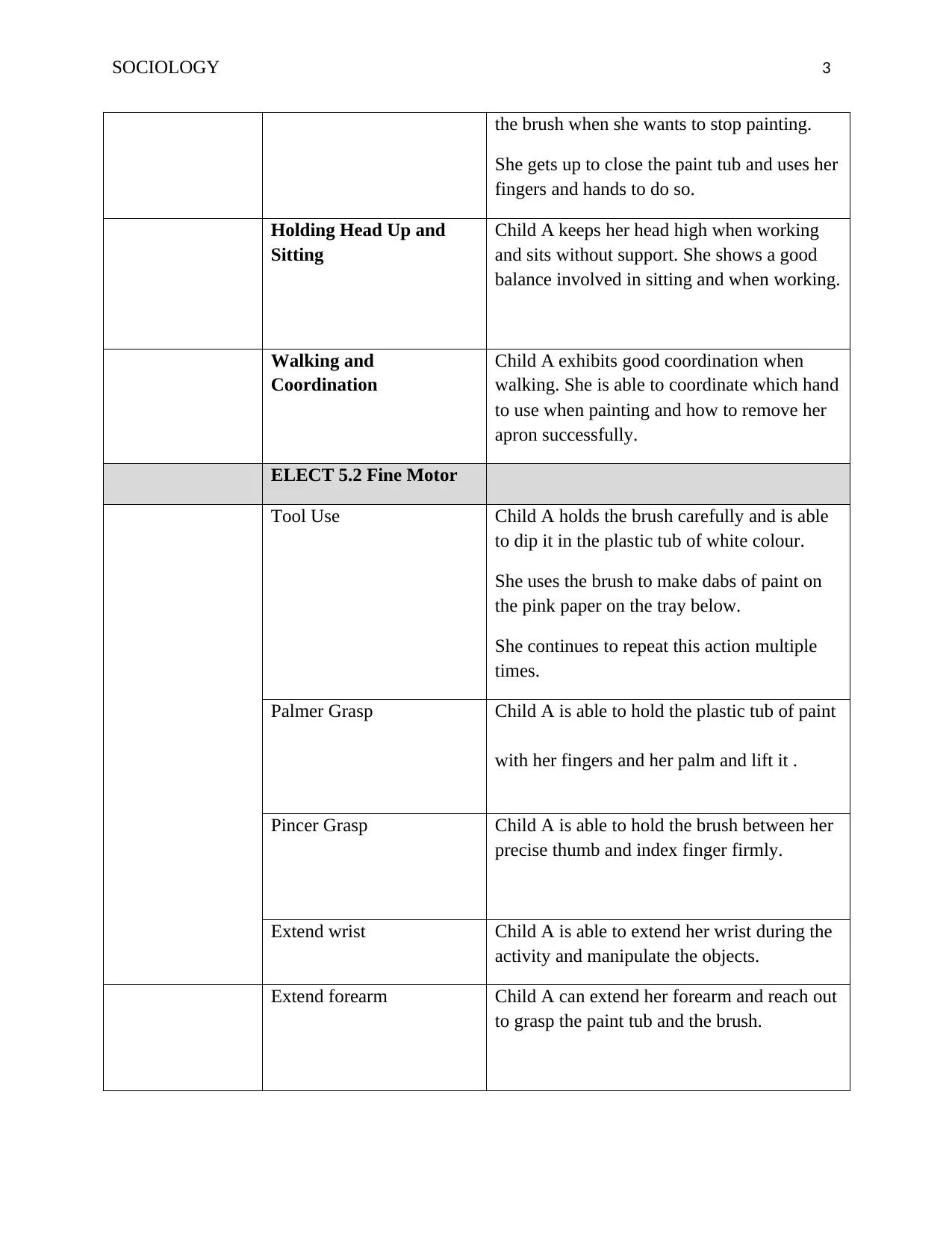
SOCIOLOGY 3
the brush when she wants to stop painting.
She gets up to close the paint tub and uses her
fingers and hands to do so.
Holding Head Up and
Sitting
Child A keeps her head high when working
and sits without support. She shows a good
balance involved in sitting and when working.
Walking and
Coordination
Child A exhibits good coordination when
walking. She is able to coordinate which hand
to use when painting and how to remove her
apron successfully.
ELECT 5.2 Fine Motor
Tool Use Child A holds the brush carefully and is able
to dip it in the plastic tub of white colour.
She uses the brush to make dabs of paint on
the pink paper on the tray below.
She continues to repeat this action multiple
times.
Palmer Grasp Child A is able to hold the plastic tub of paint
with her fingers and her palm and lift it .
Pincer Grasp Child A is able to hold the brush between her
precise thumb and index finger firmly.
Extend wrist Child A is able to extend her wrist during the
activity and manipulate the objects.
Extend forearm Child A can extend her forearm and reach out
to grasp the paint tub and the brush.
the brush when she wants to stop painting.
She gets up to close the paint tub and uses her
fingers and hands to do so.
Holding Head Up and
Sitting
Child A keeps her head high when working
and sits without support. She shows a good
balance involved in sitting and when working.
Walking and
Coordination
Child A exhibits good coordination when
walking. She is able to coordinate which hand
to use when painting and how to remove her
apron successfully.
ELECT 5.2 Fine Motor
Tool Use Child A holds the brush carefully and is able
to dip it in the plastic tub of white colour.
She uses the brush to make dabs of paint on
the pink paper on the tray below.
She continues to repeat this action multiple
times.
Palmer Grasp Child A is able to hold the plastic tub of paint
with her fingers and her palm and lift it .
Pincer Grasp Child A is able to hold the brush between her
precise thumb and index finger firmly.
Extend wrist Child A is able to extend her wrist during the
activity and manipulate the objects.
Extend forearm Child A can extend her forearm and reach out
to grasp the paint tub and the brush.
⊘ This is a preview!⊘
Do you want full access?
Subscribe today to unlock all pages.

Trusted by 1+ million students worldwide
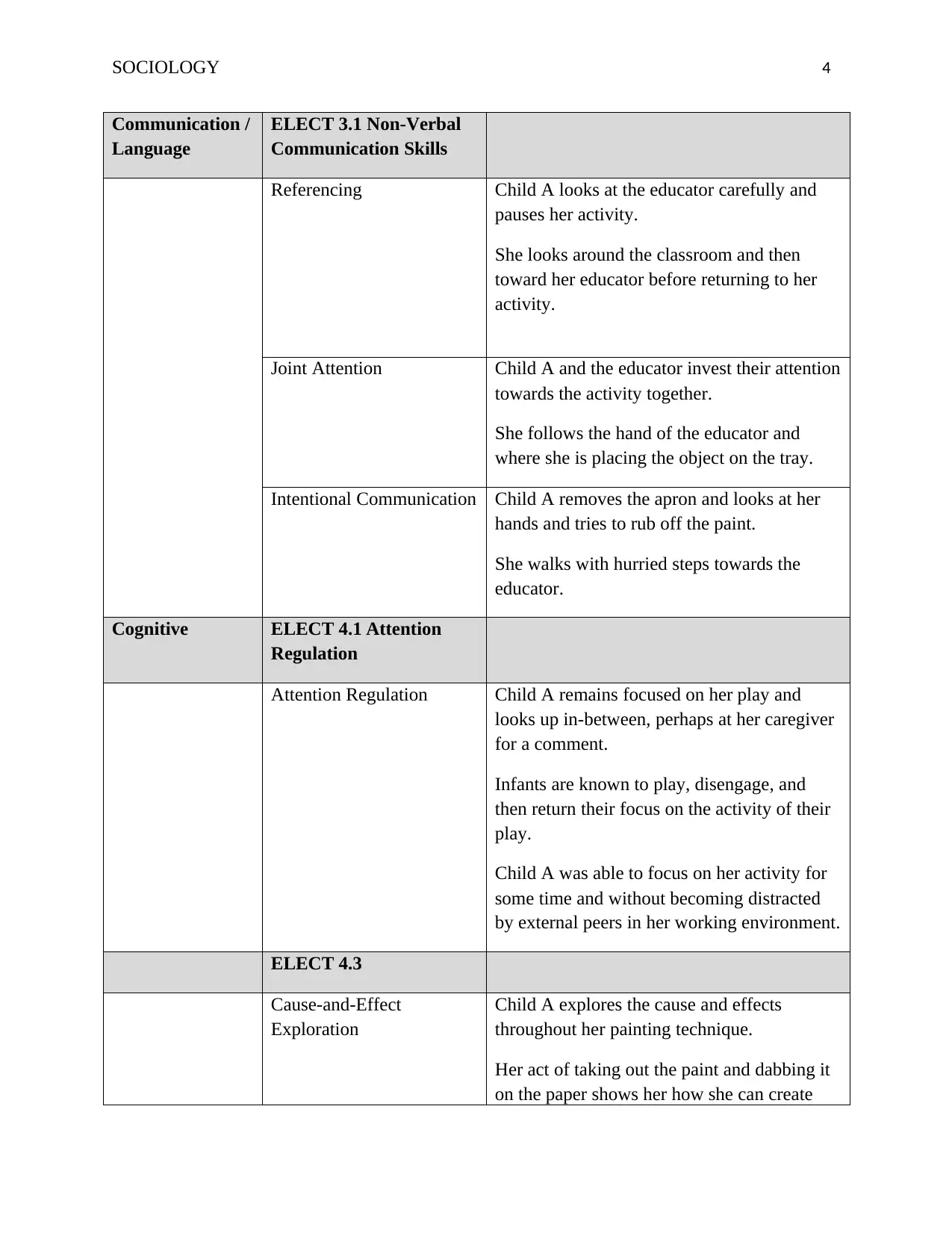
SOCIOLOGY 4
Communication /
Language
ELECT 3.1 Non-Verbal
Communication Skills
Referencing Child A looks at the educator carefully and
pauses her activity.
She looks around the classroom and then
toward her educator before returning to her
activity.
Joint Attention Child A and the educator invest their attention
towards the activity together.
She follows the hand of the educator and
where she is placing the object on the tray.
Intentional Communication Child A removes the apron and looks at her
hands and tries to rub off the paint.
She walks with hurried steps towards the
educator.
Cognitive ELECT 4.1 Attention
Regulation
Attention Regulation Child A remains focused on her play and
looks up in-between, perhaps at her caregiver
for a comment.
Infants are known to play, disengage, and
then return their focus on the activity of their
play.
Child A was able to focus on her activity for
some time and without becoming distracted
by external peers in her working environment.
ELECT 4.3
Cause-and-Effect
Exploration
Child A explores the cause and effects
throughout her painting technique.
Her act of taking out the paint and dabbing it
on the paper shows her how she can create
Communication /
Language
ELECT 3.1 Non-Verbal
Communication Skills
Referencing Child A looks at the educator carefully and
pauses her activity.
She looks around the classroom and then
toward her educator before returning to her
activity.
Joint Attention Child A and the educator invest their attention
towards the activity together.
She follows the hand of the educator and
where she is placing the object on the tray.
Intentional Communication Child A removes the apron and looks at her
hands and tries to rub off the paint.
She walks with hurried steps towards the
educator.
Cognitive ELECT 4.1 Attention
Regulation
Attention Regulation Child A remains focused on her play and
looks up in-between, perhaps at her caregiver
for a comment.
Infants are known to play, disengage, and
then return their focus on the activity of their
play.
Child A was able to focus on her activity for
some time and without becoming distracted
by external peers in her working environment.
ELECT 4.3
Cause-and-Effect
Exploration
Child A explores the cause and effects
throughout her painting technique.
Her act of taking out the paint and dabbing it
on the paper shows her how she can create
Paraphrase This Document
Need a fresh take? Get an instant paraphrase of this document with our AI Paraphraser
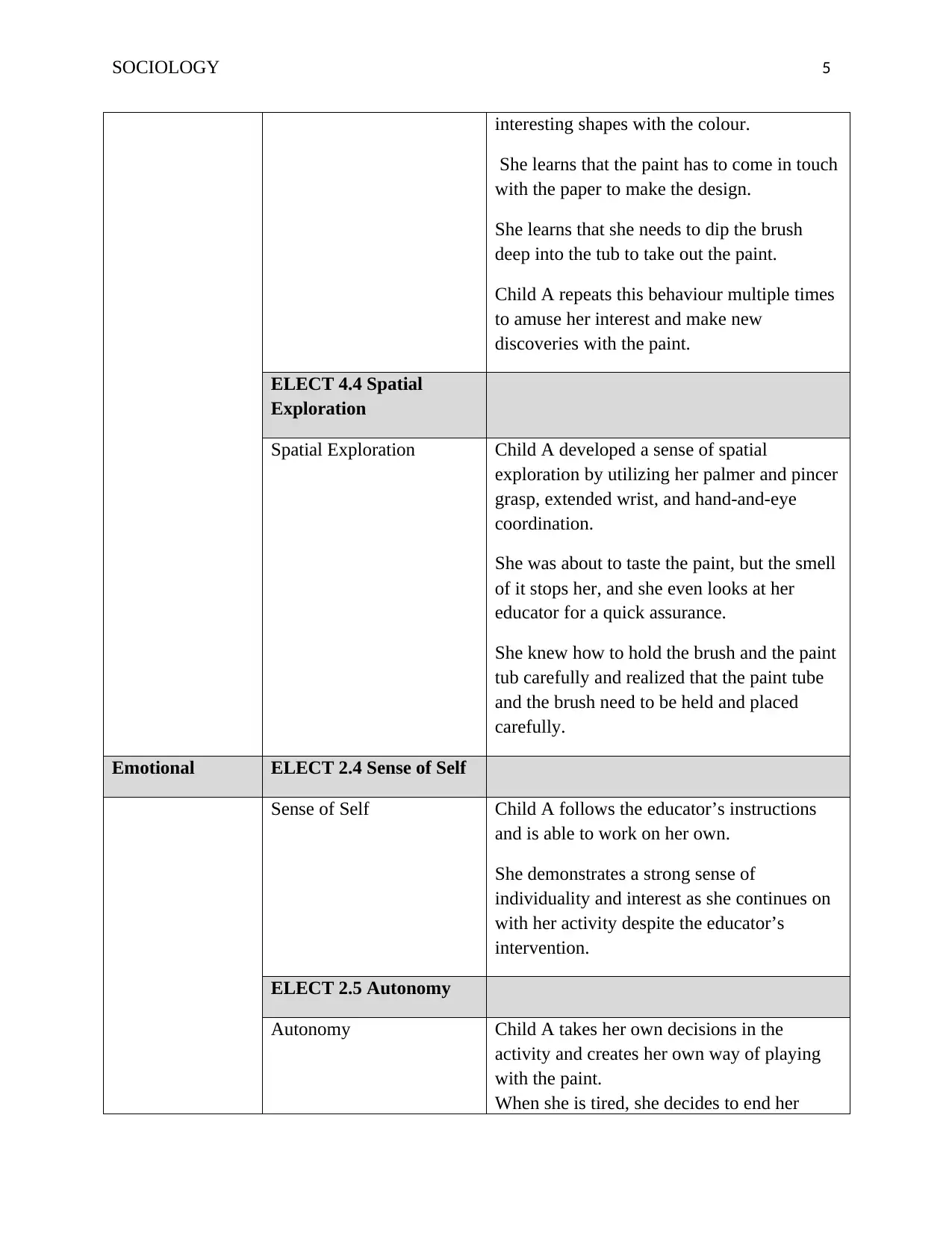
SOCIOLOGY 5
interesting shapes with the colour.
She learns that the paint has to come in touch
with the paper to make the design.
She learns that she needs to dip the brush
deep into the tub to take out the paint.
Child A repeats this behaviour multiple times
to amuse her interest and make new
discoveries with the paint.
ELECT 4.4 Spatial
Exploration
Spatial Exploration Child A developed a sense of spatial
exploration by utilizing her palmer and pincer
grasp, extended wrist, and hand-and-eye
coordination.
She was about to taste the paint, but the smell
of it stops her, and she even looks at her
educator for a quick assurance.
She knew how to hold the brush and the paint
tub carefully and realized that the paint tube
and the brush need to be held and placed
carefully.
Emotional ELECT 2.4 Sense of Self
Sense of Self Child A follows the educator’s instructions
and is able to work on her own.
She demonstrates a strong sense of
individuality and interest as she continues on
with her activity despite the educator’s
intervention.
ELECT 2.5 Autonomy
Autonomy Child A takes her own decisions in the
activity and creates her own way of playing
with the paint.
When she is tired, she decides to end her
interesting shapes with the colour.
She learns that the paint has to come in touch
with the paper to make the design.
She learns that she needs to dip the brush
deep into the tub to take out the paint.
Child A repeats this behaviour multiple times
to amuse her interest and make new
discoveries with the paint.
ELECT 4.4 Spatial
Exploration
Spatial Exploration Child A developed a sense of spatial
exploration by utilizing her palmer and pincer
grasp, extended wrist, and hand-and-eye
coordination.
She was about to taste the paint, but the smell
of it stops her, and she even looks at her
educator for a quick assurance.
She knew how to hold the brush and the paint
tub carefully and realized that the paint tube
and the brush need to be held and placed
carefully.
Emotional ELECT 2.4 Sense of Self
Sense of Self Child A follows the educator’s instructions
and is able to work on her own.
She demonstrates a strong sense of
individuality and interest as she continues on
with her activity despite the educator’s
intervention.
ELECT 2.5 Autonomy
Autonomy Child A takes her own decisions in the
activity and creates her own way of playing
with the paint.
When she is tired, she decides to end her
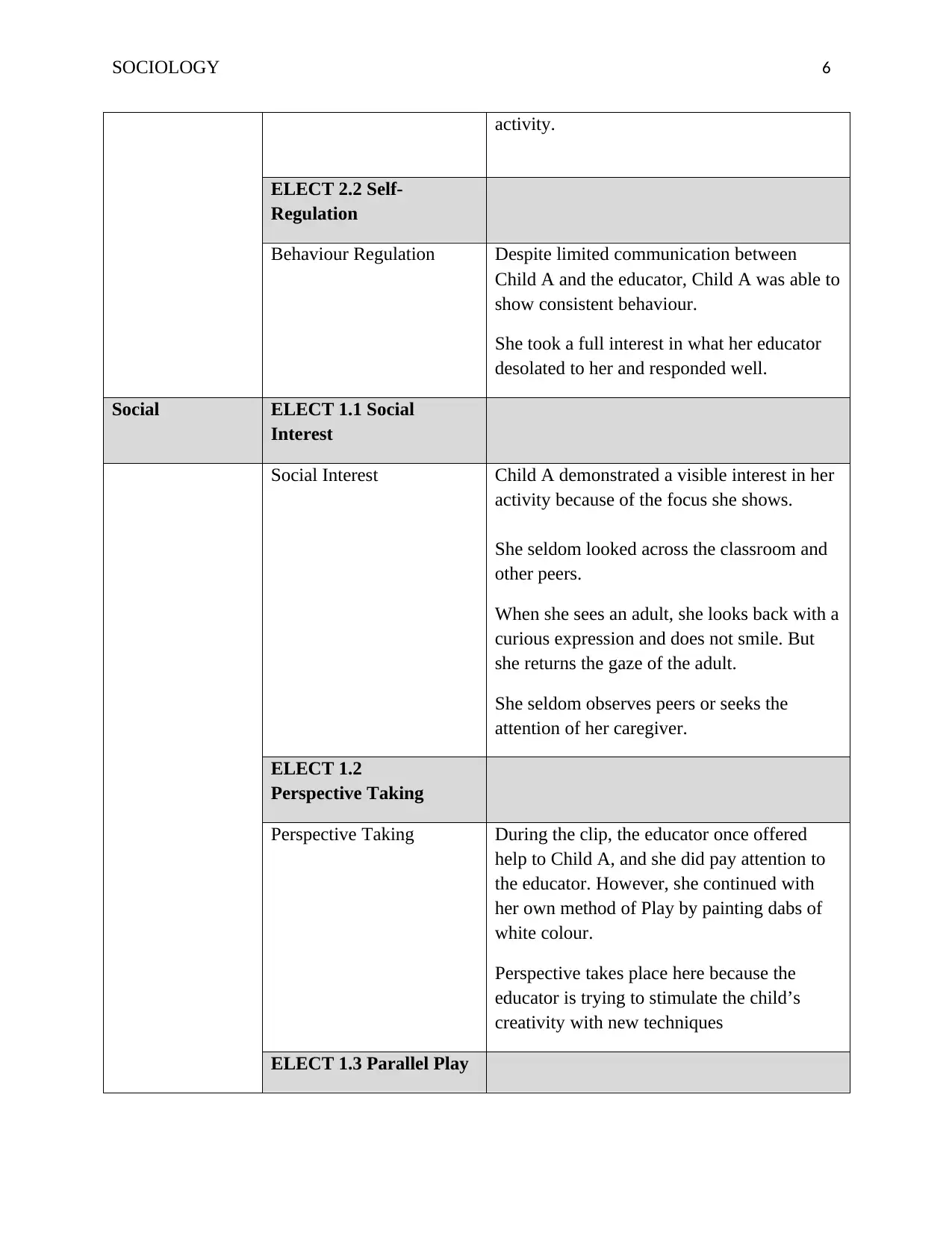
SOCIOLOGY 6
activity.
ELECT 2.2 Self-
Regulation
Behaviour Regulation Despite limited communication between
Child A and the educator, Child A was able to
show consistent behaviour.
She took a full interest in what her educator
desolated to her and responded well.
Social ELECT 1.1 Social
Interest
Social Interest Child A demonstrated a visible interest in her
activity because of the focus she shows.
She seldom looked across the classroom and
other peers.
When she sees an adult, she looks back with a
curious expression and does not smile. But
she returns the gaze of the adult.
She seldom observes peers or seeks the
attention of her caregiver.
ELECT 1.2
Perspective Taking
Perspective Taking During the clip, the educator once offered
help to Child A, and she did pay attention to
the educator. However, she continued with
her own method of Play by painting dabs of
white colour.
Perspective takes place here because the
educator is trying to stimulate the child’s
creativity with new techniques
ELECT 1.3 Parallel Play
activity.
ELECT 2.2 Self-
Regulation
Behaviour Regulation Despite limited communication between
Child A and the educator, Child A was able to
show consistent behaviour.
She took a full interest in what her educator
desolated to her and responded well.
Social ELECT 1.1 Social
Interest
Social Interest Child A demonstrated a visible interest in her
activity because of the focus she shows.
She seldom looked across the classroom and
other peers.
When she sees an adult, she looks back with a
curious expression and does not smile. But
she returns the gaze of the adult.
She seldom observes peers or seeks the
attention of her caregiver.
ELECT 1.2
Perspective Taking
Perspective Taking During the clip, the educator once offered
help to Child A, and she did pay attention to
the educator. However, she continued with
her own method of Play by painting dabs of
white colour.
Perspective takes place here because the
educator is trying to stimulate the child’s
creativity with new techniques
ELECT 1.3 Parallel Play
⊘ This is a preview!⊘
Do you want full access?
Subscribe today to unlock all pages.

Trusted by 1+ million students worldwide
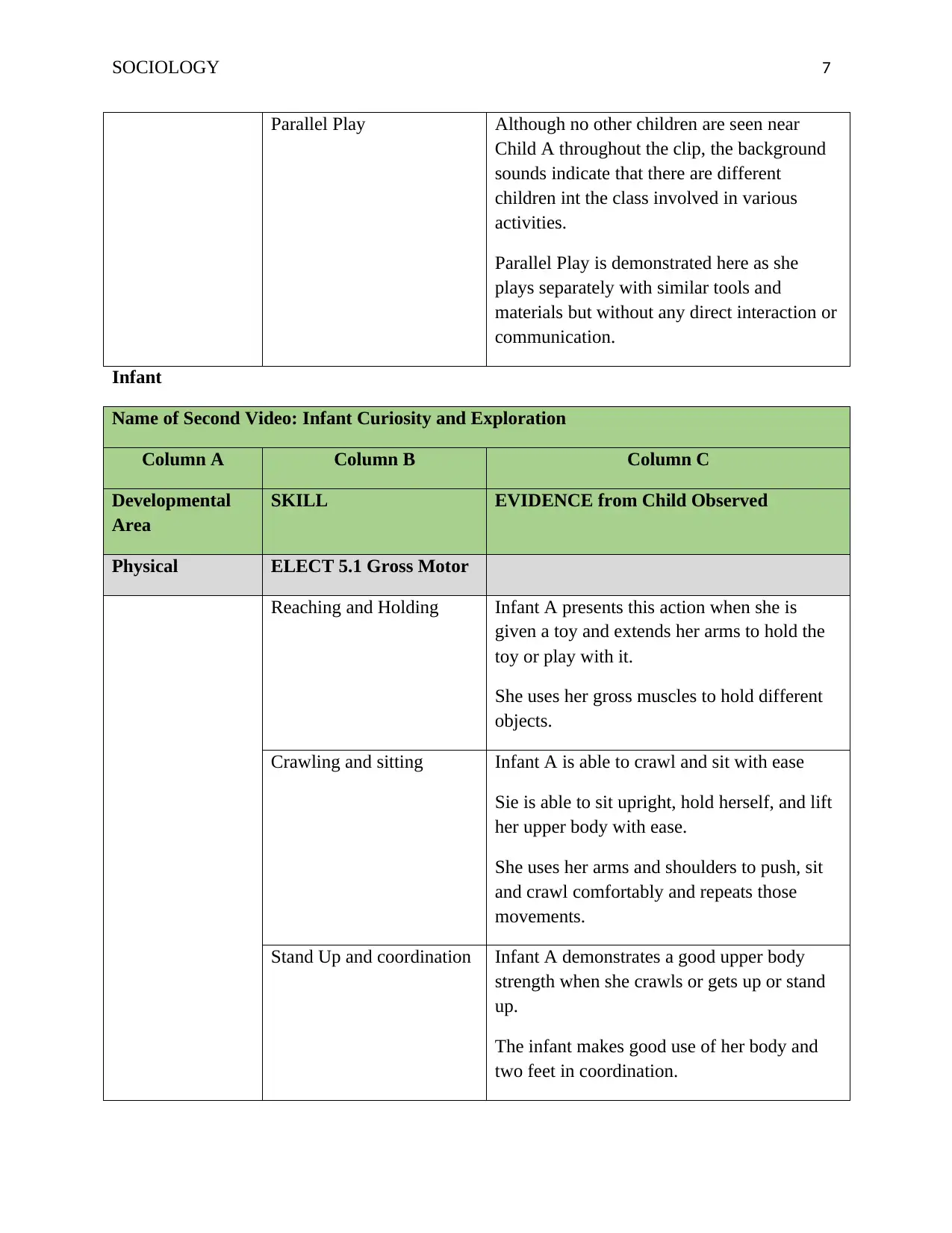
SOCIOLOGY 7
Parallel Play Although no other children are seen near
Child A throughout the clip, the background
sounds indicate that there are different
children int the class involved in various
activities.
Parallel Play is demonstrated here as she
plays separately with similar tools and
materials but without any direct interaction or
communication.
Infant
Name of Second Video: Infant Curiosity and Exploration
Column A Column B Column C
Developmental
Area
SKILL EVIDENCE from Child Observed
Physical ELECT 5.1 Gross Motor
Reaching and Holding Infant A presents this action when she is
given a toy and extends her arms to hold the
toy or play with it.
She uses her gross muscles to hold different
objects.
Crawling and sitting Infant A is able to crawl and sit with ease
Sie is able to sit upright, hold herself, and lift
her upper body with ease.
She uses her arms and shoulders to push, sit
and crawl comfortably and repeats those
movements.
Stand Up and coordination Infant A demonstrates a good upper body
strength when she crawls or gets up or stand
up.
The infant makes good use of her body and
two feet in coordination.
Parallel Play Although no other children are seen near
Child A throughout the clip, the background
sounds indicate that there are different
children int the class involved in various
activities.
Parallel Play is demonstrated here as she
plays separately with similar tools and
materials but without any direct interaction or
communication.
Infant
Name of Second Video: Infant Curiosity and Exploration
Column A Column B Column C
Developmental
Area
SKILL EVIDENCE from Child Observed
Physical ELECT 5.1 Gross Motor
Reaching and Holding Infant A presents this action when she is
given a toy and extends her arms to hold the
toy or play with it.
She uses her gross muscles to hold different
objects.
Crawling and sitting Infant A is able to crawl and sit with ease
Sie is able to sit upright, hold herself, and lift
her upper body with ease.
She uses her arms and shoulders to push, sit
and crawl comfortably and repeats those
movements.
Stand Up and coordination Infant A demonstrates a good upper body
strength when she crawls or gets up or stand
up.
The infant makes good use of her body and
two feet in coordination.
Paraphrase This Document
Need a fresh take? Get an instant paraphrase of this document with our AI Paraphraser
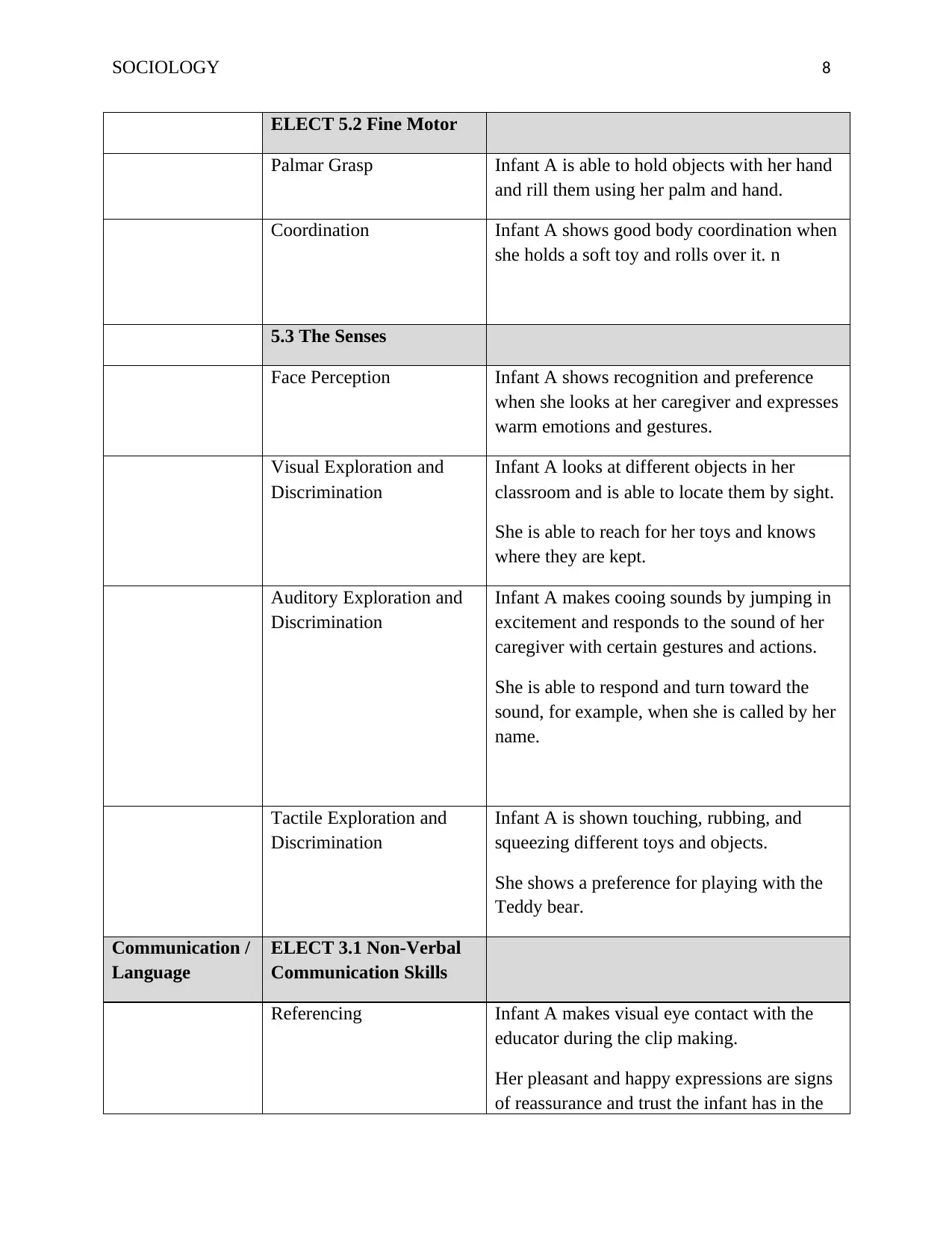
SOCIOLOGY 8
ELECT 5.2 Fine Motor
Palmar Grasp Infant A is able to hold objects with her hand
and rill them using her palm and hand.
Coordination Infant A shows good body coordination when
she holds a soft toy and rolls over it. n
5.3 The Senses
Face Perception Infant A shows recognition and preference
when she looks at her caregiver and expresses
warm emotions and gestures.
Visual Exploration and
Discrimination
Infant A looks at different objects in her
classroom and is able to locate them by sight.
She is able to reach for her toys and knows
where they are kept.
Auditory Exploration and
Discrimination
Infant A makes cooing sounds by jumping in
excitement and responds to the sound of her
caregiver with certain gestures and actions.
She is able to respond and turn toward the
sound, for example, when she is called by her
name.
Tactile Exploration and
Discrimination
Infant A is shown touching, rubbing, and
squeezing different toys and objects.
She shows a preference for playing with the
Teddy bear.
Communication /
Language
ELECT 3.1 Non-Verbal
Communication Skills
Referencing Infant A makes visual eye contact with the
educator during the clip making.
Her pleasant and happy expressions are signs
of reassurance and trust the infant has in the
ELECT 5.2 Fine Motor
Palmar Grasp Infant A is able to hold objects with her hand
and rill them using her palm and hand.
Coordination Infant A shows good body coordination when
she holds a soft toy and rolls over it. n
5.3 The Senses
Face Perception Infant A shows recognition and preference
when she looks at her caregiver and expresses
warm emotions and gestures.
Visual Exploration and
Discrimination
Infant A looks at different objects in her
classroom and is able to locate them by sight.
She is able to reach for her toys and knows
where they are kept.
Auditory Exploration and
Discrimination
Infant A makes cooing sounds by jumping in
excitement and responds to the sound of her
caregiver with certain gestures and actions.
She is able to respond and turn toward the
sound, for example, when she is called by her
name.
Tactile Exploration and
Discrimination
Infant A is shown touching, rubbing, and
squeezing different toys and objects.
She shows a preference for playing with the
Teddy bear.
Communication /
Language
ELECT 3.1 Non-Verbal
Communication Skills
Referencing Infant A makes visual eye contact with the
educator during the clip making.
Her pleasant and happy expressions are signs
of reassurance and trust the infant has in the

SOCIOLOGY 9
caregiver.
Joint Attention Joint attention is seen a couple of times
throughout the clip as the caregiver, and the
Infant A make interactions relating to a teddy
bear.
Intentional Communication Infant A makes intentional communication
when she stops and stares at her caregiver
with a look of askance and later jumps up and
dons with a smile on her face.
Gestures Infant A cuddles her stuffed bear and shows
affection towards the soft toy.
She responds to her caregiver when she calls
out” Peek-a-boo” and walks towards her
readily.
Her gestures show that she visualizes the
teddy bear to be real and is feels confident
with her caregiver.
Receptive
Language Skills
ELECT 3.2
Receptive Language
Skills
Responses Infant A responds to human voices and can
respond to a verbal request.
She goes willingly to her caregiver and sits
near her and can recognize the teddy bear by
name.
Cognitive ELECT 4.1 Attention
Regulation
Attention and Disengaging Infant A can shift her attention from one
activity to another with increasing ability.
She plays with a big toy where she is rolling
one part with colored beads. Next, she walks
across the room and then comes back to her
caregiver.
Joint Attention Joint attention is seen a couple of times
throughout the clip as the caregiver, and the
Infant A make interactions relating to a teddy
bear.
Intentional Communication Infant A makes intentional communication
when she stops and stares at her caregiver
with a look of askance and later jumps up and
dons with a smile on her face.
Gestures Infant A cuddles her stuffed bear and shows
affection towards the soft toy.
She responds to her caregiver when she calls
out” Peek-a-boo” and walks towards her
readily.
Her gestures show that she visualizes the
teddy bear to be real and is feels confident
with her caregiver.
Receptive
Language Skills
ELECT 3.2
Receptive Language
Skills
Responses Infant A responds to human voices and can
respond to a verbal request.
She goes willingly to her caregiver and sits
near her and can recognize the teddy bear by
name.
Cognitive ELECT 4.1 Attention
Regulation
Attention and Disengaging Infant A can shift her attention from one
activity to another with increasing ability.
She plays with a big toy where she is rolling
one part with colored beads. Next, she walks
across the room and then comes back to her
⊘ This is a preview!⊘
Do you want full access?
Subscribe today to unlock all pages.

Trusted by 1+ million students worldwide

SOCIOLOGY 10
caregiver and starts playing with the Teddy
bear.
Attention Regulation Infant A kept keeps distracting herself with
the different objects in the classroom, and she
is able to regulate her attention based on the
toy or object she is fascinated with.
At times, her attention and interest are guided
by her caregiver a few times by the caregiver
in the clip.
Even though the infant likes to explore the
room on her own, her actions are guided by
the caregiver.
ELECT 4.3 Cause-and-
Effect Exploration
Exploration with actions Infant A repeats her actions as she keeps
rolling the toys and tries to crawl and then
come back.
ELECT 4.1 Self-
Regulation
Attention Regulation Infant A kept keeps distracting herself with
the different objects in the classroom and she
is able to regulate her attention based on the
toy or object she is fascinated with.
At times, her attention and interest are guided
by her caregiver a few times by the caregiver
in the clip.
Even though the infant likes to explore the
room on her own, her actions are guided by
the caregiver.
ELECT 4.4 Spatial
caregiver and starts playing with the Teddy
bear.
Attention Regulation Infant A kept keeps distracting herself with
the different objects in the classroom, and she
is able to regulate her attention based on the
toy or object she is fascinated with.
At times, her attention and interest are guided
by her caregiver a few times by the caregiver
in the clip.
Even though the infant likes to explore the
room on her own, her actions are guided by
the caregiver.
ELECT 4.3 Cause-and-
Effect Exploration
Exploration with actions Infant A repeats her actions as she keeps
rolling the toys and tries to crawl and then
come back.
ELECT 4.1 Self-
Regulation
Attention Regulation Infant A kept keeps distracting herself with
the different objects in the classroom and she
is able to regulate her attention based on the
toy or object she is fascinated with.
At times, her attention and interest are guided
by her caregiver a few times by the caregiver
in the clip.
Even though the infant likes to explore the
room on her own, her actions are guided by
the caregiver.
ELECT 4.4 Spatial
Paraphrase This Document
Need a fresh take? Get an instant paraphrase of this document with our AI Paraphraser
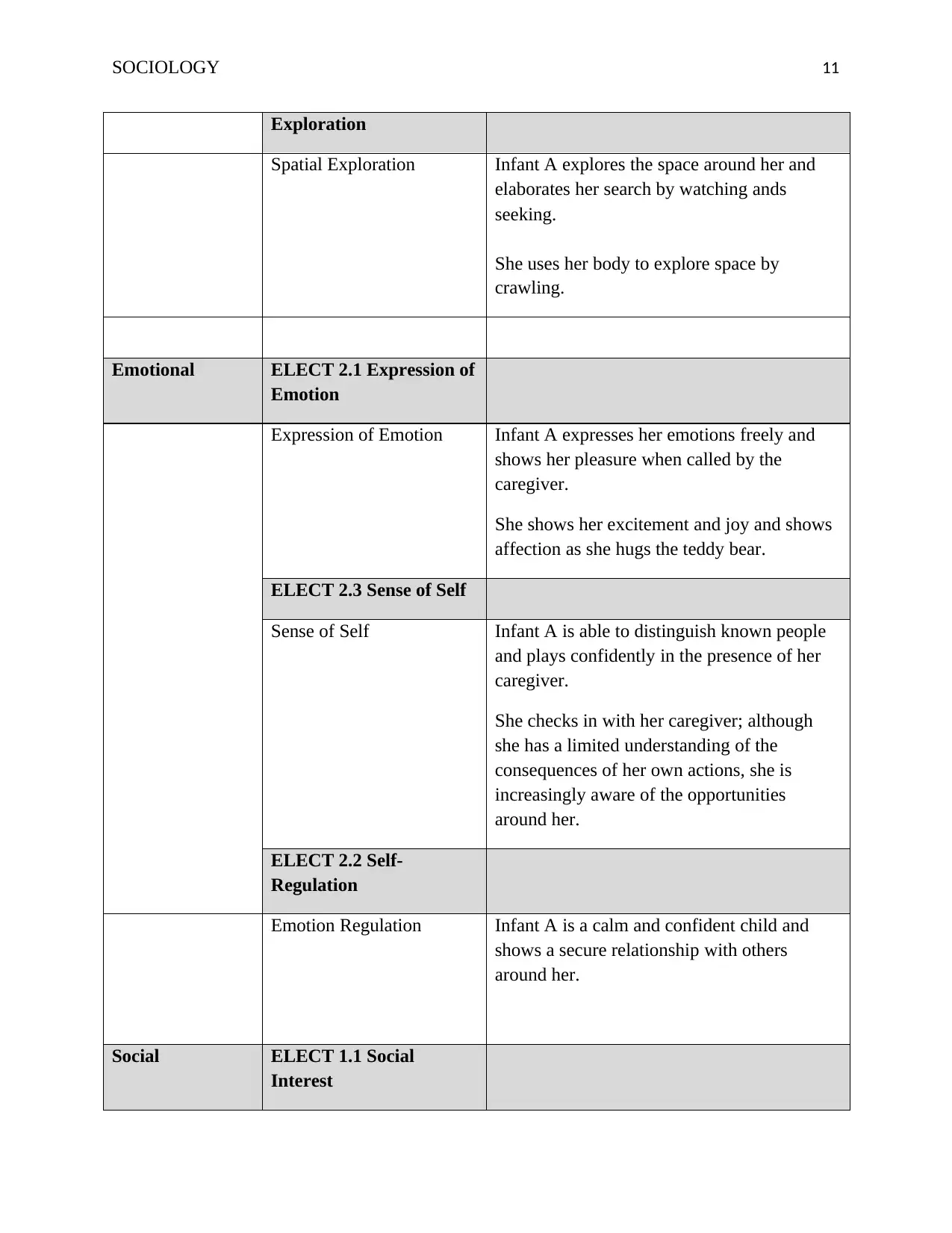
SOCIOLOGY 11
Exploration
Spatial Exploration Infant A explores the space around her and
elaborates her search by watching ands
seeking.
She uses her body to explore space by
crawling.
Emotional ELECT 2.1 Expression of
Emotion
Expression of Emotion Infant A expresses her emotions freely and
shows her pleasure when called by the
caregiver.
She shows her excitement and joy and shows
affection as she hugs the teddy bear.
ELECT 2.3 Sense of Self
Sense of Self Infant A is able to distinguish known people
and plays confidently in the presence of her
caregiver.
She checks in with her caregiver; although
she has a limited understanding of the
consequences of her own actions, she is
increasingly aware of the opportunities
around her.
ELECT 2.2 Self-
Regulation
Emotion Regulation Infant A is a calm and confident child and
shows a secure relationship with others
around her.
Social ELECT 1.1 Social
Interest
Exploration
Spatial Exploration Infant A explores the space around her and
elaborates her search by watching ands
seeking.
She uses her body to explore space by
crawling.
Emotional ELECT 2.1 Expression of
Emotion
Expression of Emotion Infant A expresses her emotions freely and
shows her pleasure when called by the
caregiver.
She shows her excitement and joy and shows
affection as she hugs the teddy bear.
ELECT 2.3 Sense of Self
Sense of Self Infant A is able to distinguish known people
and plays confidently in the presence of her
caregiver.
She checks in with her caregiver; although
she has a limited understanding of the
consequences of her own actions, she is
increasingly aware of the opportunities
around her.
ELECT 2.2 Self-
Regulation
Emotion Regulation Infant A is a calm and confident child and
shows a secure relationship with others
around her.
Social ELECT 1.1 Social
Interest
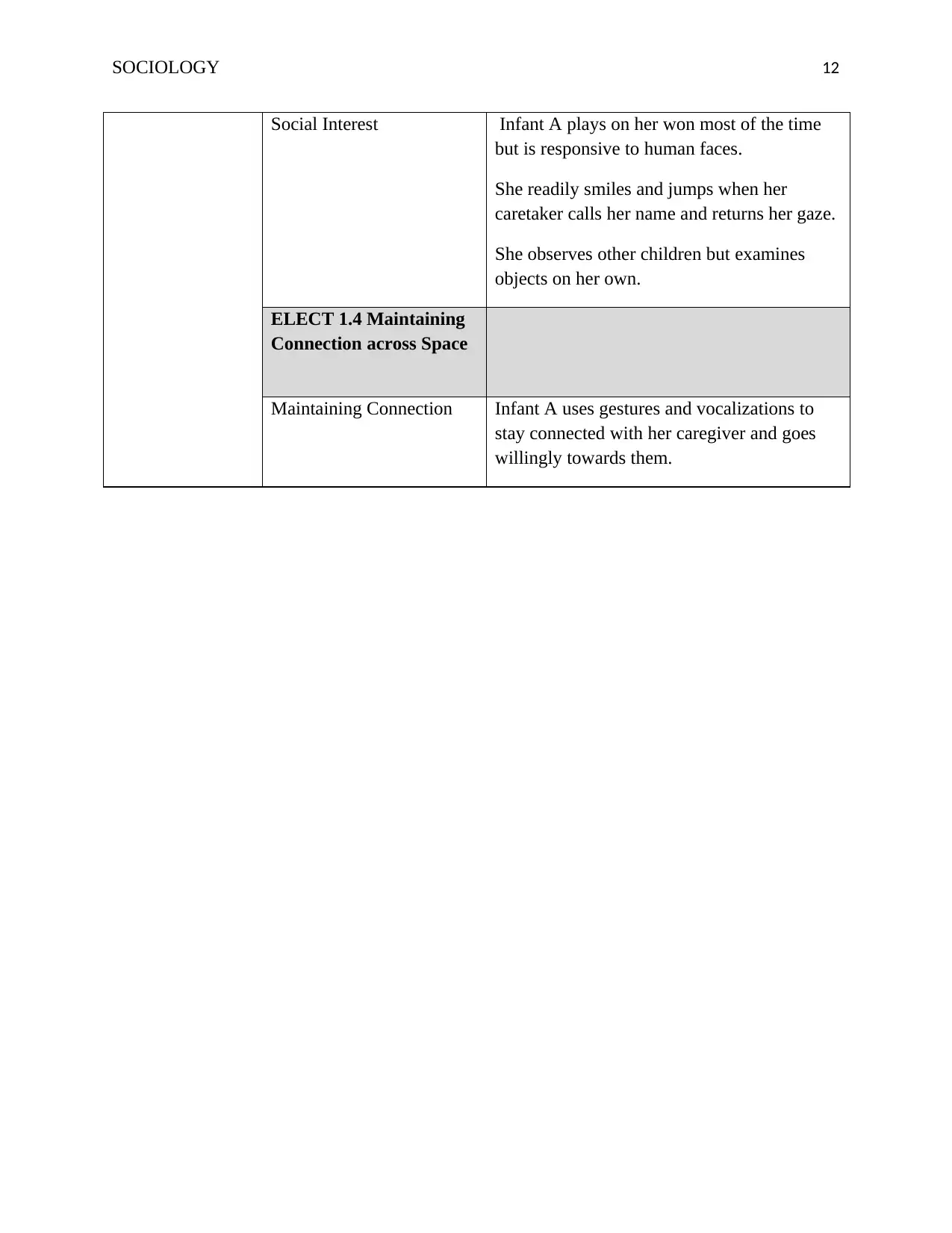
SOCIOLOGY 12
Social Interest Infant A plays on her won most of the time
but is responsive to human faces.
She readily smiles and jumps when her
caretaker calls her name and returns her gaze.
She observes other children but examines
objects on her own.
ELECT 1.4 Maintaining
Connection across Space
Maintaining Connection Infant A uses gestures and vocalizations to
stay connected with her caregiver and goes
willingly towards them.
Social Interest Infant A plays on her won most of the time
but is responsive to human faces.
She readily smiles and jumps when her
caretaker calls her name and returns her gaze.
She observes other children but examines
objects on her own.
ELECT 1.4 Maintaining
Connection across Space
Maintaining Connection Infant A uses gestures and vocalizations to
stay connected with her caregiver and goes
willingly towards them.
⊘ This is a preview!⊘
Do you want full access?
Subscribe today to unlock all pages.

Trusted by 1+ million students worldwide
1 out of 24
Your All-in-One AI-Powered Toolkit for Academic Success.
+13062052269
info@desklib.com
Available 24*7 on WhatsApp / Email
![[object Object]](/_next/static/media/star-bottom.7253800d.svg)
Unlock your academic potential
Copyright © 2020–2025 A2Z Services. All Rights Reserved. Developed and managed by ZUCOL.


